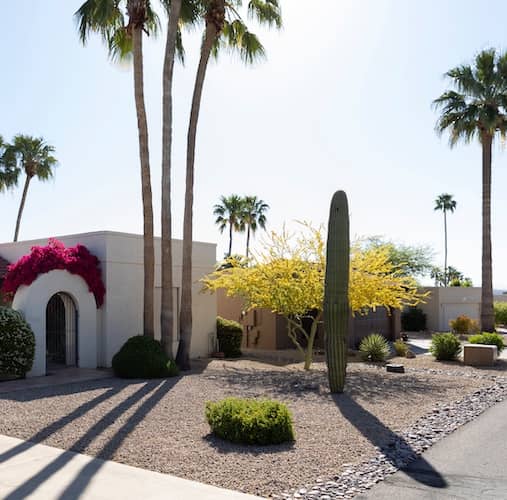$350,000 mortgage: Total cost and other factors to consider
Feb 16, 2024
•10-minute read
If you’re thinking about purchasing a house sometime fairly soon, it’s important to develop a home buying budget that will suit your needs and long-term financial goals. Perhaps that budget is a $350K mortgage.
Let’s take a look at the total cost of a $350,000 mortgage and your monthly payments based on various scenarios, including your interest rate and loan term. We’ll also explore some factors to consider before applying for a $350K mortgage, as well as how to get one.
Monthly payments on a $350,000 mortgage
When you take out a mortgage of any size, you can expect to pay some upfront costs (which we’ll get into later) in addition to some monthly expenses, which include the principal and interest components of your mortgage loan, plus property taxes and insurance. Next, we’ll consider each of these.
- Principal: The principal is the total loan amount you borrowed to purchase your home, and you’ll pay it off monthly over the course of your loan’s repayment term.
- Interest: Also part of your monthly payment is interest, which is the money you agreed to pay your lender for providing you the funds you needed to make a home purchase. The amount you’ll pay in interest each month will depend in part on your interest rate, which is a percentage of your remaining loan amount.
- Taxes: No matter where you decide to call home, you’ll pay yearly property taxes. The amount you’ll need to pay to your local government will vary with the property tax rate for your area and your assessed home value.
- Insurance: Two common types of insurance that must be factored into your monthly payment are homeowners insurance and mortgage insurance. Homeowners insurance provides financial protection against some natural disasters and accidents that may occur on your property. Not every homeowner has to pay mortgage insurance, but your lender may require it to protect their investment in the event of a default on your home loan.
Crunching the numbers
Let’s take a look at your estimated monthly payment on a $350,000 mortgage for a variety of fixed interest rates as well as both a 15-year loan term and a 30-year term. Note that this table accounts only for principal and interest. Property taxes, homeowners insurance and mortgage insurance aren’t included.
| Interest rate | 15-year loan term | 30-year loan term |
|---|---|---|
|
6% |
$2,954 |
$2,098 |
|
6.25% |
$3,001 |
$2,155 |
|
6.5% |
$3,049 |
$2,212 |
|
6.75% |
$3,097 |
$2,270 |
|
7% |
$3,146 |
$2,329 |
|
7.25% |
$3,195 |
$2,388 |
|
7.5% |
$3,245 |
$2,447 |
|
7.75% |
$3,294 |
$2,507 |
|
8% |
$3,345 |
$2,568 |
As you can see above, borrowers with a 15-year term mortgage pay more each month than those with a 30-year term. However, homeowners with a 15-year loan term usually secure a lower interest rate along with paying off their debt in half the time and saving thousands of dollars over the life of the loan.
Factors to consider before applying for a $350,000 mortgage
In addition to your monthly mortgage payment, you’ll want to consider several other factors before applying for a $350,000 mortgage. Let’s break them down one-by-one.
Down payment
Depending on the kind of mortgage loan you sign up for, you may be required to make a down payment on your home. In any case, you’ll have a more manageable monthly mortgage payment the more money you put down upfront.
That’s because your principal mortgage balance starting out will be less than if you put no money or less money down. On a conventional loan, which you can sometimes get with a down payment of as little as 3% of the purchase price, it’s best if you can put down no less than 20%. That way, you can avoid paying private mortgage insurance (PMI) and having extra PMI fees included as part of your monthly mortgage bill. Take into consideration your current savings and how much of that you’re planning to contribute to a down payment.
Closing costs
Closing costs are another one-time expense you need to plan for when taking out a mortgage. In most cases, you can expect to be required to pay 3% – 6% of the loan amount in closing costs. That comes out to somewhere in the $10,500 – $21,000 range on a $350K mortgage.
Closing costs often include the following fees, although not all home purchase transactions have the same closing costs:
- An application fee
- An attorney’s fee
- A closing fee
- A courier fee
- A credit reporting fee
- A homeowners association transfer fee
- A loan origination fee
- An appraisal fee
- Escrow fees
Loan term
As we briefly touched on above, you’ll need to decide on a loan term for your mortgage. You can choose between the common 30-year and 15-year term options, or you may be able to go with a far less common 20-year term.
If you have the means to pay more per month, you may be best opting for a 15-year loan, while a 30-year loan is likely the best option if you can’t afford to make higher monthly payments at the time of purchase.
Adjustable-rate vs. fixed-rate mortgage
One of the most important decisions you’ll make concerning your loan is whether to go with a fixed-rate or an adjustable-rate mortgage. With the latter option, your interest rate will be set for a period of several years – known as the fixed period – after which it can change every year or so based on fluctuations in market rates.
With a fixed-rate mortgage, your interest rate will never change for as long as you owe money on the home. That said, the amount of your monthly mortgage payment could still go up or down with any changes in the amount you owe in property taxes and homeowners insurance from year to year. Homeowners like fixed-rate mortgages for their predictability relative to adjustable-rate loans, but the big upside of an adjustable-rate mortgage is that you can typically secure a lower interest rate for the first few years.
Knowing the differences between these mortgages is key to understanding your monthly payment on your $350,000 mortgage and how it may change over time.
Qualification requirements
To be approved for a $350,000 mortgage, you’ll need to meet your lender’s qualification requirements. Typical requirements for a conventional loan include not just a minimum 3% down payment, as mentioned earlier, but also a credit score of at least 620, a maximum debt-to-income ratio (DTI) of 50%, and an income that can support both your monthly mortgage payment and other life expenses and bills.
How much total interest would you pay on a $350k mortgage?
The total amount of interest you’ll pay on a $350K mortgage will depend on your interest rate – sometimes known as annual percentage rate (APR) – and the length of your loan term.
Let’s say, hypothetically, that you end up with a 30-year mortgage loan featuring a 7% APR. In this case, the total amount you’ll pay in interest will be $488,281.14. But with a 15-year mortgage featuring the same rate and the same $350,000 amount, you’ll pay only $216,261.81 in interest over the duration of the loan term.
To play around with numbers of your own, you can use our amortization calculator and get a sense of the amount you’ll pay in interest with a $350K mortgage.
Amortization schedule for a $350,000 mortgage
To analyze your payments over the life of your loan, you may find it helpful to look at an amortization schedule for your mortgage. An amortization schedule is a breakdown of your total monthly payment, the amount paid in principal, the amount paid in interest and your remaining balance.
Consider the following example of an amortization schedule for a $350,000 mortgage loan that extends 30 years and carries a 6.5% APR. Keep in mind, though, that this amortization schedule has a yearly breakdown of interest paid and principal paid, whereas a typical amortization schedule breaks all of your payments down by month.
| Year | Starting balance | Estimated monthly payment | Interest paid | Principal paid | Remaining balance |
|---|---|---|---|---|---|
|
1 |
$350,000 |
$2,212 |
$22,634.82 |
$3,912.04 |
$346,087.96 |
|
2 |
$346,087.96 |
$2,212 |
$22,372.82 |
$4,174.04 |
$341,913.93 |
|
3 |
$341,913.93 |
$2,212 |
$22,093.28 |
$4,453.58 |
$337,460.35 |
|
4 |
$337,460.35 |
$2,212 |
$21,795.01 |
$4,751.84 |
$332,708.50 |
|
5 |
$332,708.50 |
$2,212 |
$21,476.77 |
$5,070.08 |
$327,638.42 |
|
6 |
$327,638.42 |
$2,212 |
$21,137.22 |
$5,409.64 |
$322,228.79 |
|
7 |
$322,228.79 |
$2,212 |
$20,774.93 |
$5,771.93 |
$316,456.86 |
|
8 |
$316,456.86 |
$2,212 |
$20,388.37 |
$6,158.49 |
$310,298.37 |
|
9 |
$310,298.37 |
$2,212 |
$19,975.93 |
$6,570.93 |
$303,727.44 |
|
10 |
$303,727.44 |
$2,212 |
$19,535.86 |
$7,011 |
$296,716.44 |
|
11 |
$296,716.44 |
$2,212 |
$19,066.32 |
$7,480.54 |
$289,235.90 |
|
12 |
$289,235.90 |
$2,212 |
$18,565.33 |
$7,981.52 |
$281,254.38 |
|
13 |
$281,254.38 |
$2,212 |
$18,030.80 |
$8,516.06 |
$272,738.32 |
|
14 |
$272,738.32 |
$2,212 |
$17,460.46 |
$9,086.40 |
$263,651.92 |
|
15 |
$263,651.92 |
$2,212 |
$16,851.93 |
$9,694.93 |
$253,956.99 |
|
16 |
$253,956.99 |
$2,212 |
$16,202.64 |
$10,344.22 |
$243,612.78 |
|
17 |
$243,612.78 |
$2,212 |
$15,509.87 |
$11,036.99 |
$232,575.79 |
|
18 |
$232,575.79 |
$2,212 |
$14,770.70 |
$11,776.16 |
$220,799.63 |
|
19 |
$220,799.63 |
$2,212 |
$13,982.03 |
$12,564.83 |
$208,234.81 |
|
20 |
$208,234.81 |
$2,212 |
$13,140.54 |
$13,406.32 |
$194,828.49 |
|
21 |
$194,828.49 |
$2,212 |
$12,242.69 |
$14,304.16 |
$180,524.33 |
|
22 |
$180,524.33 |
$2,212 |
$11,284.72 |
$15,262.14 |
$165,262.19 |
|
23 |
$165,262.19 |
$2,212 |
$10,262.58 |
$16,284.27 |
$148,977.91 |
|
24 |
$148,977.91 |
$2,212 |
$9,172 |
$17,374.86 |
$131,603.05 |
|
25 |
$131,603.05 |
$2,212 |
$8,008.37 |
$18,538.49 |
$113,064.57 |
|
26 |
$113,064.57 |
$2,212 |
$6,766.81 |
$19,780.04 |
$93,284.52 |
|
27 |
$93,284.52 |
$2,212 |
$5,442.11 |
$21,104.75 |
$72,179.77 |
|
28 |
$72,179.77 |
$2,212 |
$4,028.68 |
$22,518.17 |
$49,661.60 |
|
29 |
$49,661.60 |
$2,212 |
$2,520.60 |
$24,026.26 |
$25,635.34 |
|
30 |
$25,635.34 |
$2,212 |
$911.52 |
$25,635.34 |
$0.00 |
Now, let’s take a look at how the amortization schedule would look for the same loan amount and APR but with a 15-year loan term.
| Year | Starting balance | Estimated monthly payment | Interest paid | Principal paid | Remaining balance |
|---|---|---|---|---|---|
|
1 |
$350,000 |
$3,049 |
$22,330.25 |
$14,256.26 |
$335,743.74 |
|
2 |
$335,743.74 |
$3,049 |
$21,375.49 |
$15,211.02 |
$320,532.72 |
|
3 |
$320,532.72 |
$3,049 |
$20,356.77 |
$16,229.73 |
$304,302.99 |
|
4 |
$304,302.99 |
$3,049 |
$19,269.84 |
$17,316.67 |
$286,986.32 |
|
5 |
$286,986.32 |
$3,049 |
$18,110.11 |
$18,476.40 |
$268,509.92 |
|
6 |
$268,509.92 |
$3,049 |
$16,872.71 |
$19,713.80 |
$248,796.12 |
|
7 |
$248,796.12 |
$3,049 |
$15,552.44 |
$21,034.07 |
$227,762.05 |
|
8 |
$227,762.05 |
$3,049 |
$14,143.75 |
$22,442.76 |
$205,319.29 |
|
9 |
$205,319.29 |
$3,049 |
$12,640.72 |
$23,945.79 |
$181,373.50 |
|
10 |
$181,373.50 |
$3,049 |
$11,037.02 |
$25,549.49 |
$155,824.02 |
|
11 |
$155,824.02 |
$3,049 |
$9,325.93 |
$27,260.58 |
$128,563.43 |
|
12 |
$128,563.43 |
$3,049 |
$7,500.24 |
$29,086.27 |
$99,477.16 |
|
13 |
$99,477.16 |
$3,049 |
$5,552.27 |
$31,034.23 |
$68,442.93 |
|
14 |
$68,442.93 |
$3,049 |
$3,473.85 |
$33,112.65 |
$35,330.27 |
|
15 |
$35,330.27 |
$3,049 |
$1,256.24 |
$35,330.27 |
$0.00 |
How to get a $350,000 mortgage
Once you’ve determined you can afford a $350K mortgage and have decided on the term length and type of mortgage loan, it’s time to get the application process started. Next is a brief summary of the steps needed to land a $350,000 mortgage.
Step 1: Apply for preapproval and get preapproved
The first step in locking down your $350K mortgage is to get preapproved. Once you’re preapproved, your lender will send you a preapproval letter stating how much they’re willing to lend you. They’ll base their decision on your income, assets and credit. Once you have this letter, real estate agents and sellers will know you’re a serious buyer who has the funding to back up your home purchase offer.
Step 2: Find the house you want and make an offer
Now for the fun part – finding a property and making an offer. When you’re trying to find the right home for your situation and needs, it’s best to reach out to an experienced real estate agent. This individual will draw up your purchase offer for you when the time is right and negotiate with the seller’s agent, if necessary, on the price you’re willing to pay and any seller concessions you might need.
Step 3: Confirm the details
Next, an underwriter who works for your lender will verify your finances and assets, along with the details of the property you’re looking to buy. At this point, you’ll also likely want to work with your real estate agent to schedule an inspection, although inspections are optional with conventional loans. A home appraisal, meanwhile, will be required unless you’re fortunate enough to secure an appraisal waiver, which is possible under certain circumstances.
After you’ve received final loan approval from your lender, and just days before your scheduled closing, your lender will send you a Closing Disclosure that provides you with the key details of your loan. These will include your down payment amount, if any, along with your monthly payment, closing costs and interest rate.
Step 4: Close on your mortgage loan
The final step of the home buying process is showing up for your closing day – when you’ll sign the final loan documents and get the keys to your new home. Typically, your real estate agent will be present at the closing, which will likely take place at the law office of the closing attorney. Be sure to bring a valid photo ID and have your closing costs and any down payment amount sent via bank wire to the attorney’s office before arriving. Someone from your closing attorney’s office will provide directions on how to proceed with this so the money goes to the right place.
FAQs about a $350K mortgage
Let’s take a look at some of the most frequently asked questions about a $350K mortgage.
What will the monthly payment be on a $350,000 mortgage?
The monthly payment on a $350,000 mortgage will depend on several factors unique to the borrower, including the length of your loan term, the interest rate determined by your lender, and the cost of your property taxes, homeowners insurance and any mortgage insurance you may need to pay.
How much will the down payment be for a $350,000 mortgage?
The down payment needed for a $350,000 mortgage will vary depending on which type of loan you choose and the purchase price of your home. For example, if you buy a home for $380,000, you’ll need to make a down payment of $30,000 to end up with a $350,000 mortgage. Some loan programs require no down payment, while others require down payments of varying sizes.
What credit score do I need to get a $350K mortgage?
The required credit score for a $350K loan will vary by loan type and lender. No matter what, though, you can expect a better interest rate the better your credit score. Most lenders require a minimum credit score of 620 to grant approval for a conventional loan.
What salary do I need to afford a $350,000 mortgage?
The 28/36 rule is a good place to start when trying to determine how much income you’ll need for a $350K mortgage. This rule states that you shouldn’t spend more than 28% of your gross monthly income on housing costs or more than 36% of your gross monthly income on all monthly debt payments.
To see the size of the mortgage you can afford when following the 28/36 rule, use our home affordability calculator by entering your prospective home’s ZIP code, your annual gross income, the amount you pay in monthly debts, your credit score range, and how much money you have for a down payment and closing costs. The mortgage calculator will then tell you how large of a loan you can afford.
When should I consider getting a smaller mortgage?
You should consider getting a smaller mortgage if you know you won’t be able to comfortably afford your monthly mortgage payment alongside your other regular expenses. Before you apply for a $350K mortgage, it’s wise to evaluate your financial situation and ensure that this budget is right for you.
The bottom line
When beginning the home buying process, you may not know how large of a mortgage is feasible for your finances. If you’re interested in a $350,000 mortgage, make sure to crunch the numbers to uncover the affordability of your monthly mortgage payment in combination with your other bills and expenses. It may help to plug in different interest rates, loan term lengths, and insurance and property tax costs to see what would work best for you.
Are you ready to take out a mortgage? You can start your mortgage application today with the Home Loan Experts at Rocket Mortgage®.

Victoria Araj
Victoria is a former Team Leader of editorial content at Rocket Mortgage and she held roles in mortgage banking, public relations and more in her 19+ years with the company. She holds a bachelor’s degree in journalism with an emphasis in political science from Michigan State University, and a master’s degree in public administration from the University of Michigan.
Related resources

5-minute read
What’s the average mortgage payment in Arizona?
Read more

7-minute read
What is the average monthly mortgage payment in Georgia?
Discover the average monthly mortgage payment in Georgia, the criteria that affect it, and how it compares nationally. Learn key facts and figures to budget for...
Read more

7-minute read
15- vs. 20- vs. 30-year mortgage: Which is best?
Your mortgage term will influence how much you pay in interest, your monthly payment, and more. Compare common loan terms before you apply for financing.
Read more